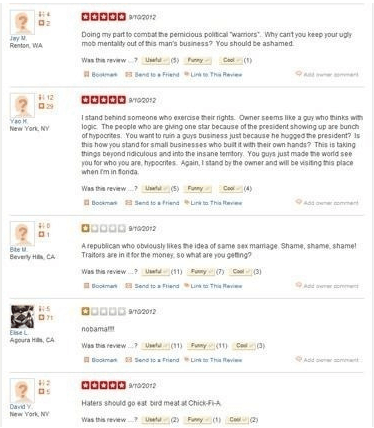 Do you remember the story of Florida pizza shop owner, Scott Van Duzer, who hugged President Obama during a campaign stop in 2012?
Do you remember the story of Florida pizza shop owner, Scott Van Duzer, who hugged President Obama during a campaign stop in 2012?
The President stopped by Van Duzer’s restaurant to recognize him for his efforts in helping provide blood to patients in his county. What Van Duzer didn’t expect was the big bear hug he gave the President to make national news…and bring out the trolls on his company’s Yelp page.
People from across the country began leaving negative reviews on the page, even if they’d never actually eaten in the restaurant. One reviewer wrote, “Most of y’all Democrats can’t afford to eat at this restaurant anyway. They don’t accept food stamps.”
Hundreds of anti-Obama reviewers flooded the page to criticize Van Duzer, his restaurant, and his political beliefs.
In working with Yelp, Van Duzer was able to have some of the comments removed because they violated the site’s content guidelines, yet many remained. But then something magical happened: Van Duzer’s loyal customers came to the rescue! They began leaving five star reviews, having actually eaten in the restaurant, and the negative and untrue reviews were pushed further and further down.
Clean-Up Your Online Reputation
If you have some unsavory things hurting you online – and you don’t have a community to come to your rescue – you can clean-up your online reputation with some elbow grease and a good strategy in place.
The process goes a little something like this.
- Conduct an online audit. Likely you already know what’s there, but it doesn’t hurt to do a Google search, see what is being said, and where it lands in search results (second listing, first page). Do this both logged into your Google account and logged out (or you can open an incognito tab in your browser without having to actually log out by going to file > new incognito window). Logged in will let you see the results your friends, colleagues, peers, and clients will see. The incognito search will show you what the rest of the world sees. It’s important to have both. Search Google, Bing, and Yahoo. Search the social networks. Search the review sites. Search the Better Business Bureau and Ripoff Report. Search employee sites such as Glassdoor. Use terms such as “I hate COMPANY NAME” or “COMPANY NAME sucks.”
- Create a strategy. Based on what you learn from the audit and what internal and external implementation resources are in place, put together the company’s online strategy … and make sure it’s tied to your goals. The very first thing you should do (if you haven’t already) is set up Talkwalker alerts to let you know when someone says something about you online – positive, neutral, or negative.
- Create a clean-up list. With the audit complete and your online strategy in place, now comes the clean-up. In some cases, there will be multiple accounts for your organization. There might be profiles you don’t need on social networks that are either defunct or they don’t help your strategy. There might be negative reviews or blog posts on the first page of search results you’d like to address and not have come up before your own sites and the positive reviews. Maybe there are “I hate Company X” groups on Facebook or untrue reviews on Yelp or TripAdvisor. Perhaps former employees have said really terrible things about you on Glassdoor or they’ve set up social networks for the company and you don’t have the login information. Whatever it happens to be, the list begins with these types of things. Write down everything you need cleaned up so the person or team responsible understands what it is you want done.
- Assign someone (or a team) to do the work. They will need usernames and passwords, branding guidelines, sign-off on copy/images, and the power to make changes without a laborious approval process. It’s not critical this person be in marketing or PR, as long as it’s someone who understands what you’re trying to accomplish and can get the work done and update you in a timely manner.
- Begin the clean-up. Some of this is a big pain in the rear because you’ll need to work with the customer service departments at the social networks to either reset login data, delete a profile, or take down an untrue review. This could take weeks. We have a client who had an employee who was very social media savvy. He set up the company on all of the social networks and then quit his job, taking the login information with him. Working with LinkedIn, in particular, took about five weeks to reset the password and give us additional administrator access. In some cases, such as on the review sites, you have to prove the review is untrue, sometimes with legal action.
- Build your online presence through social media. There is one social network every organization should be on: Google+. Not only does Google rank you higher if you use their social network to promote your content, it helps to push down the negative content if it has been shared on Google+. You don’t have to be “social” on the site, but please use it to promote your content.
- Content is king…or at least prince. There are going to be many of you who have negative reviews that are, unfortunately, true. There are many organizations who claim they will clean up your online reputation for $40 per month, deleting all of the negative reviews from search results. This is illegal. Not illegal from the “I’ll be arrested and spend time in jail” point-of-view, but from a “It’s impossible to delete things on a site where you are not an administrator” perspective. Good, valuable content that is shared is the only way to push some the negative results.
- Implement the strategy. Once you’ve cleaned up the organization’s online presence and figured out how you’re going to use content to build a strong reputation, it’s time to put your strategy into action. This is the scary part. You’re about to become transparent. The curtain has been pulled back now and the only way to participate in the conversation is by being transparent, which means you’re opening yourself up to criticism and feedback.
Once you’ve decided to be transparent, honest, authentic, and human in your online conversations, the content, brand ambassadors, influencer marketing, customer reviews, and a solid product or service will help you cross the marathon finish line.
Warren Buffett famously said, “If you lose money for the firm, I will be understanding. If you lose reputation, I will be ruthless.”
An organization’s reputation, today, is only as good as its search results. If your operations are solid, you have a responsive customer service team, and you run things ethically, the rest will sort itself out.
